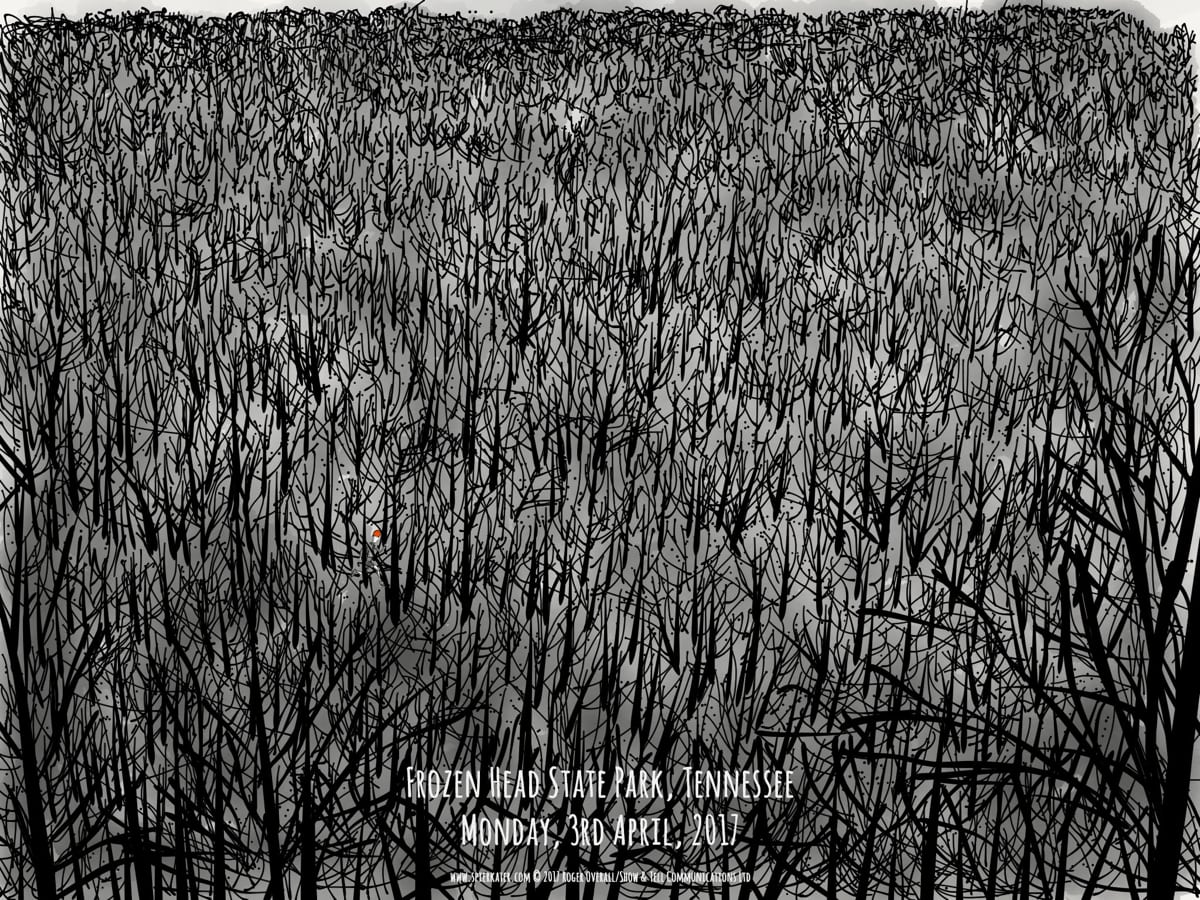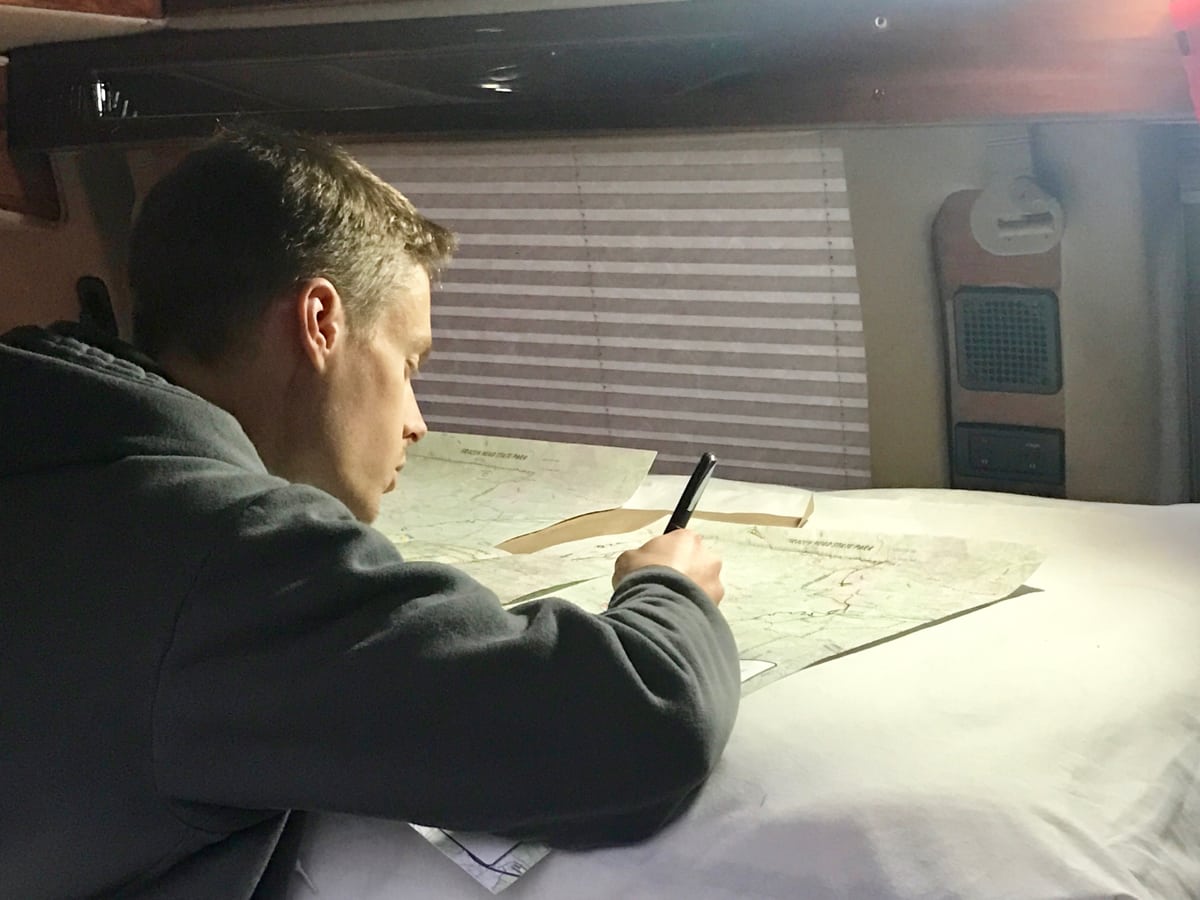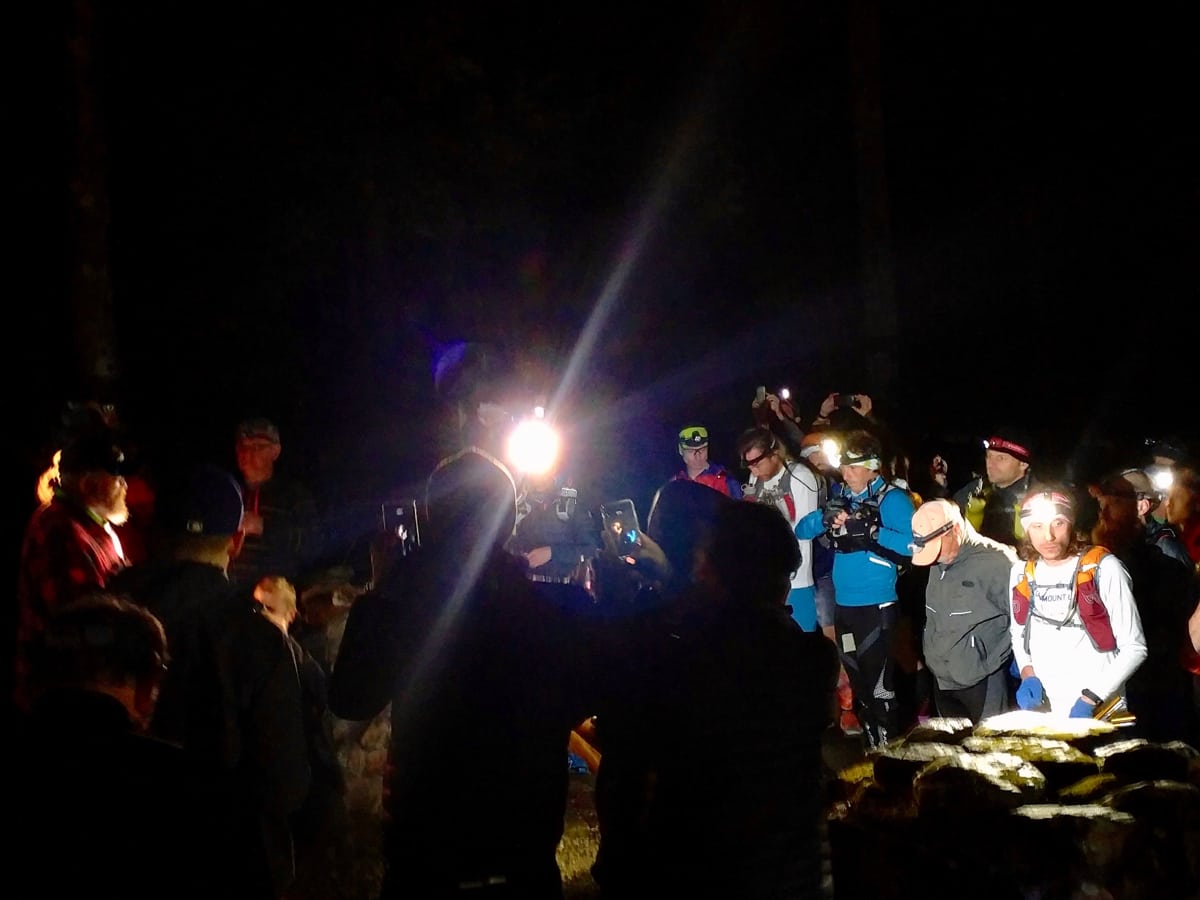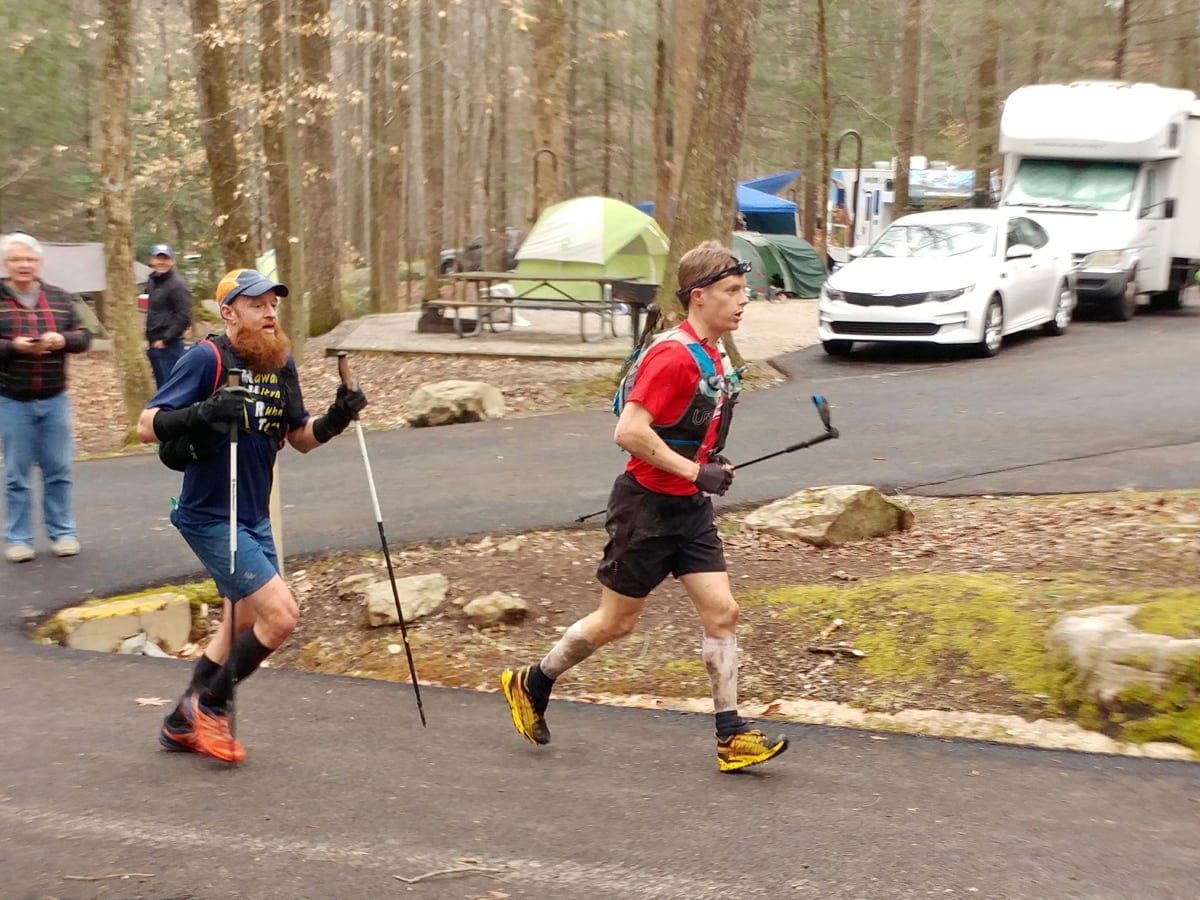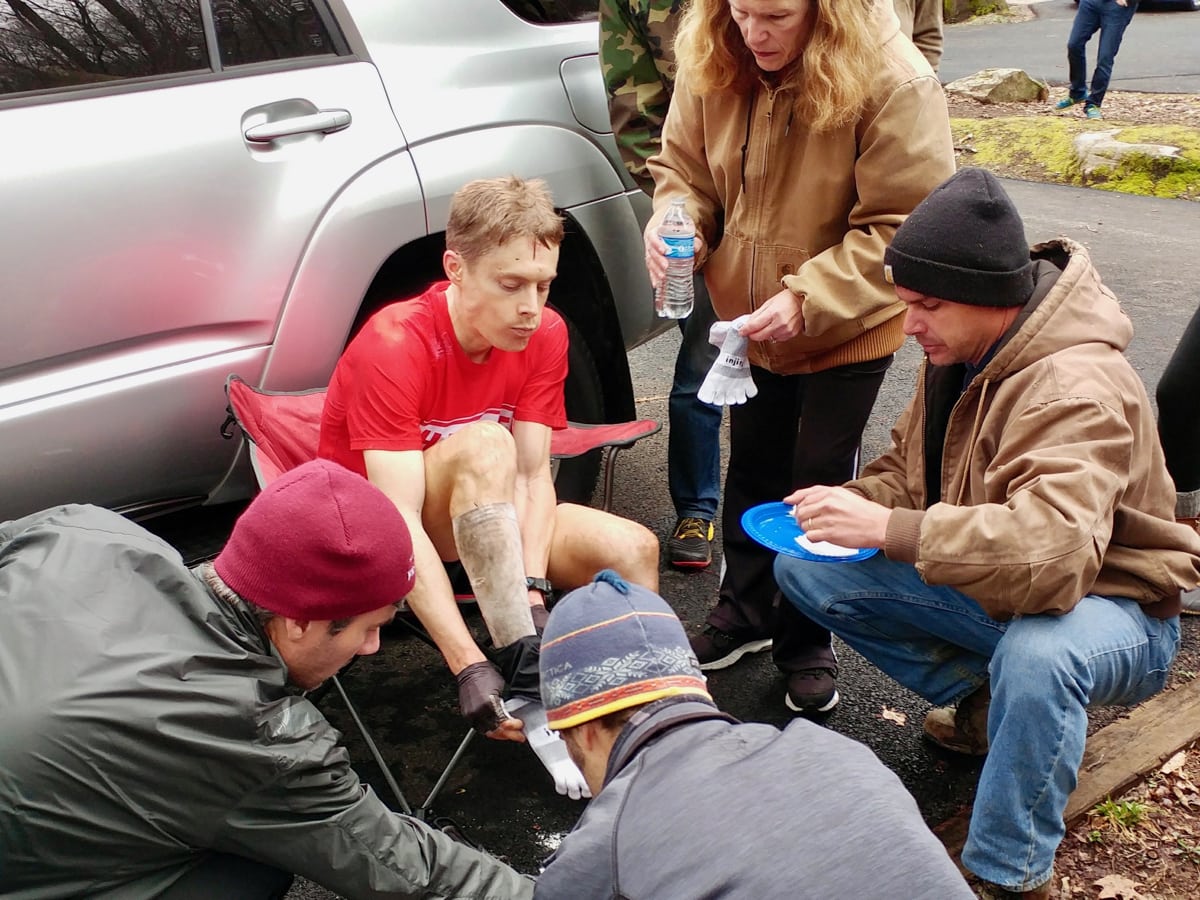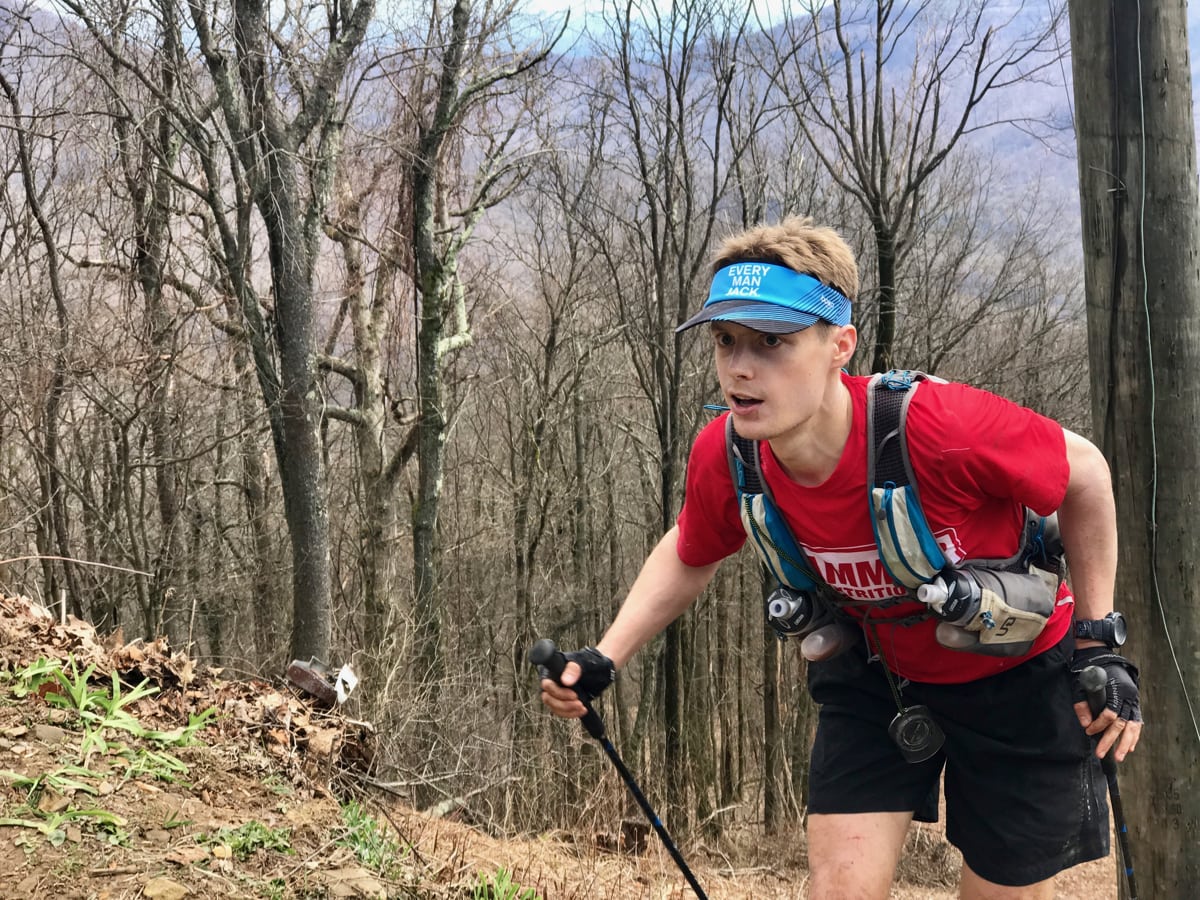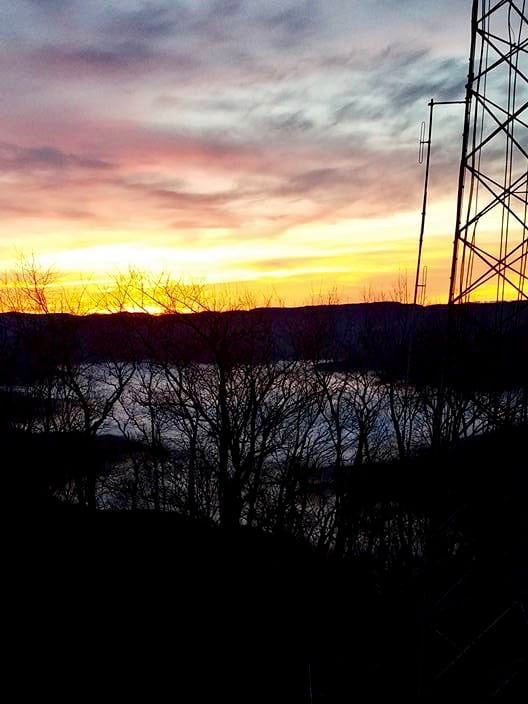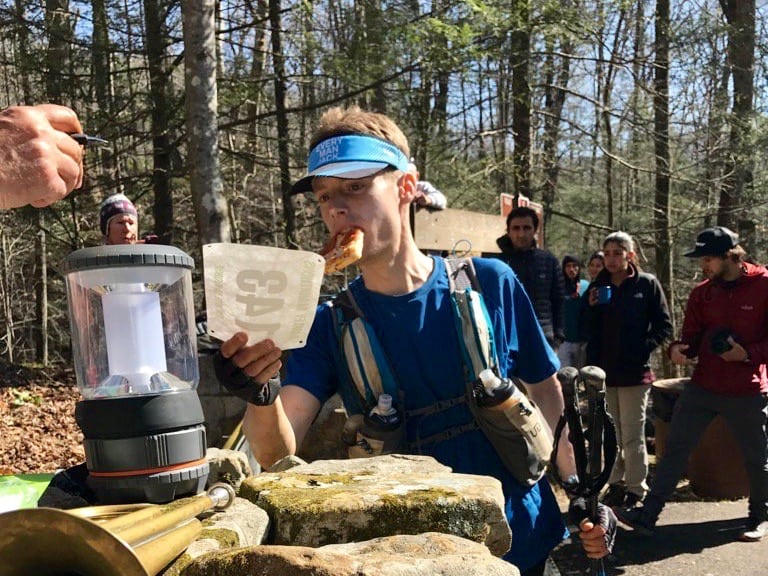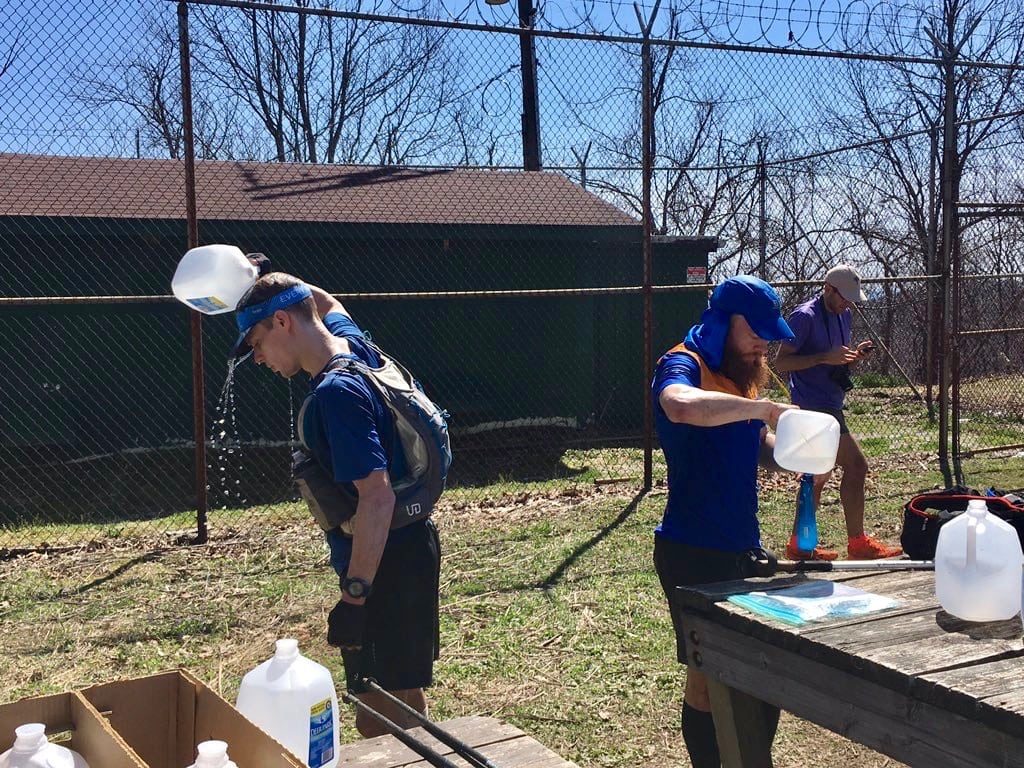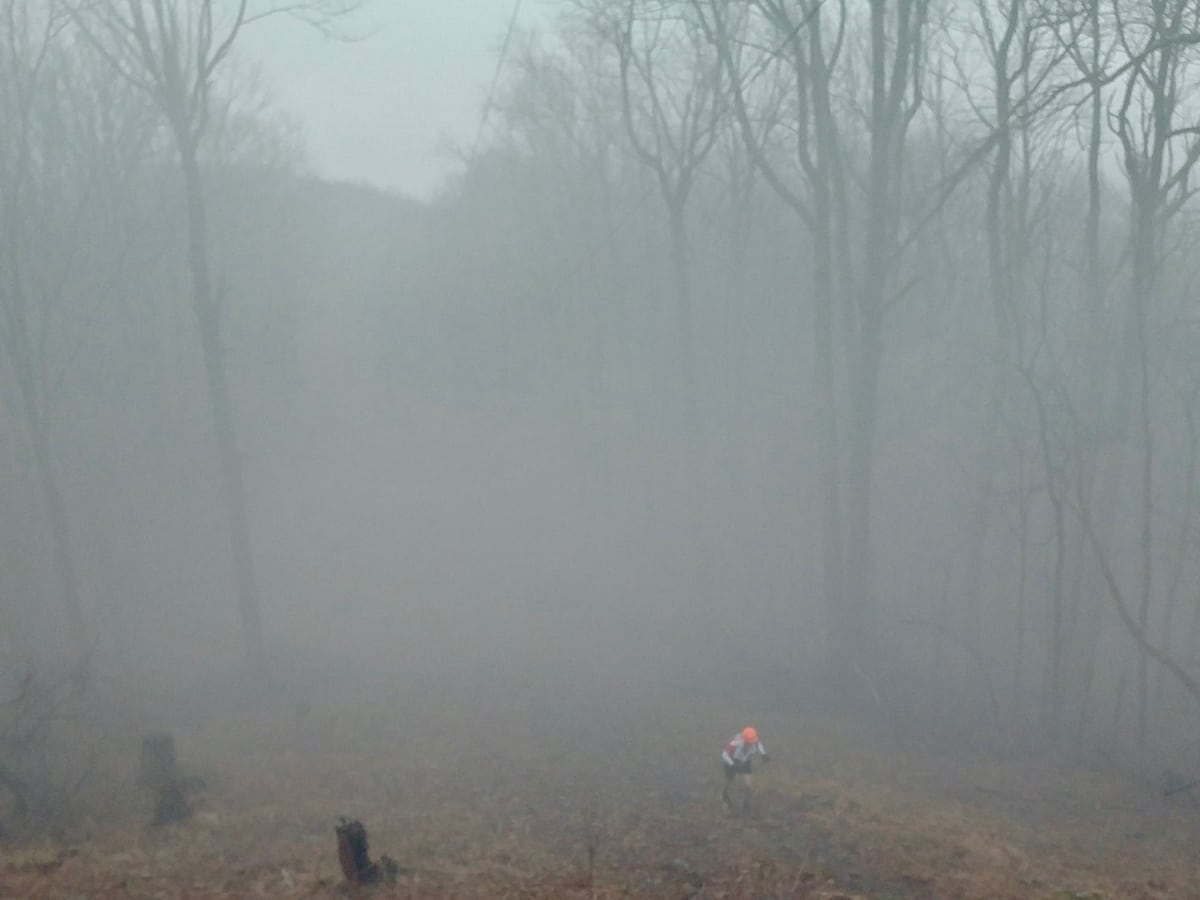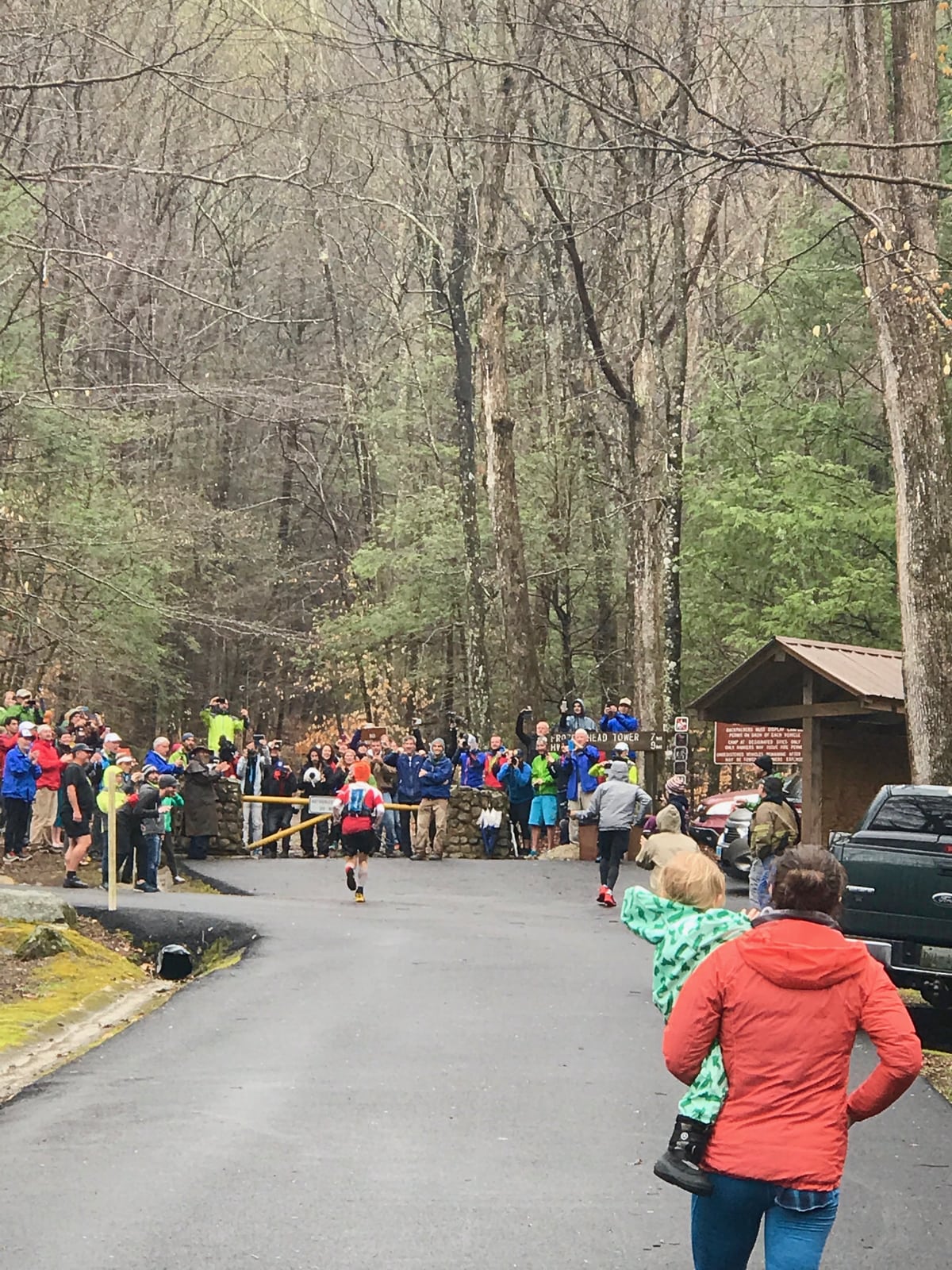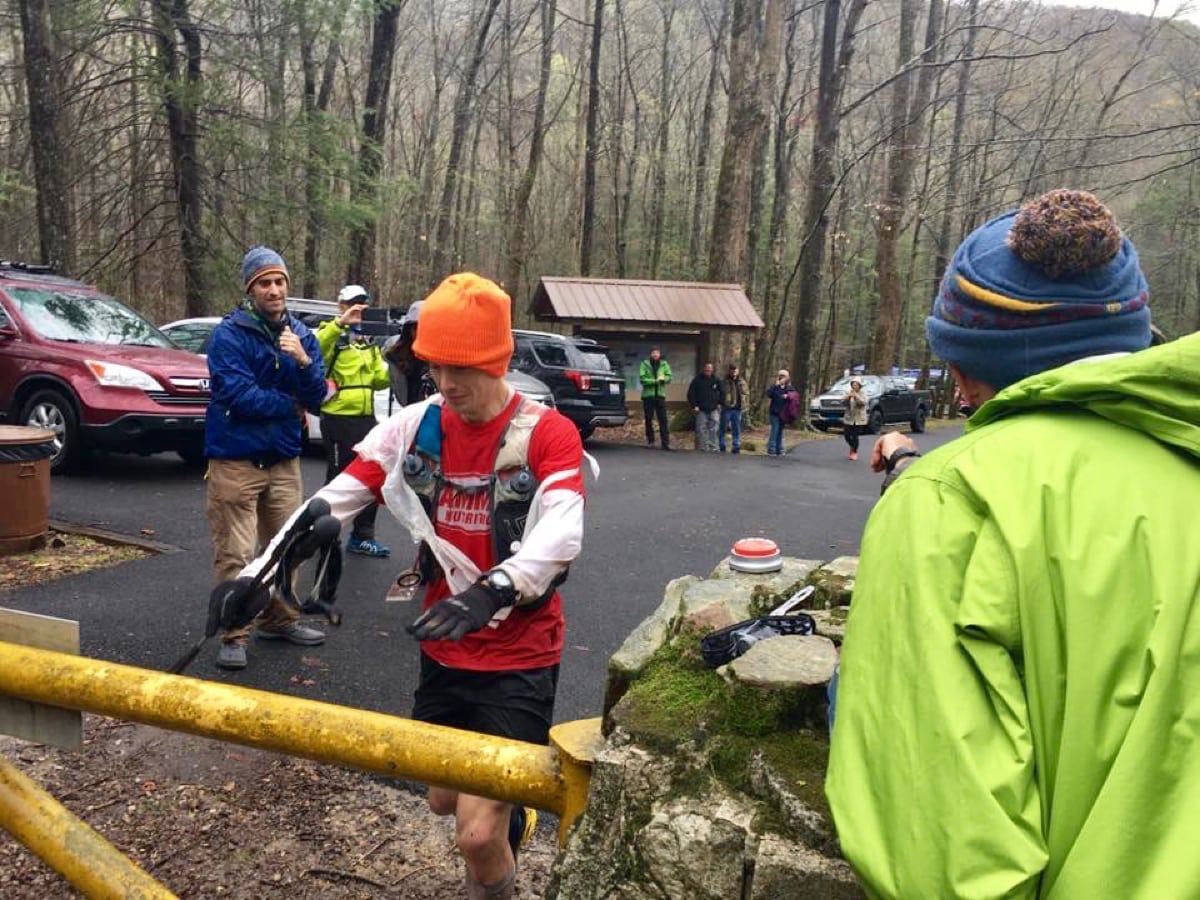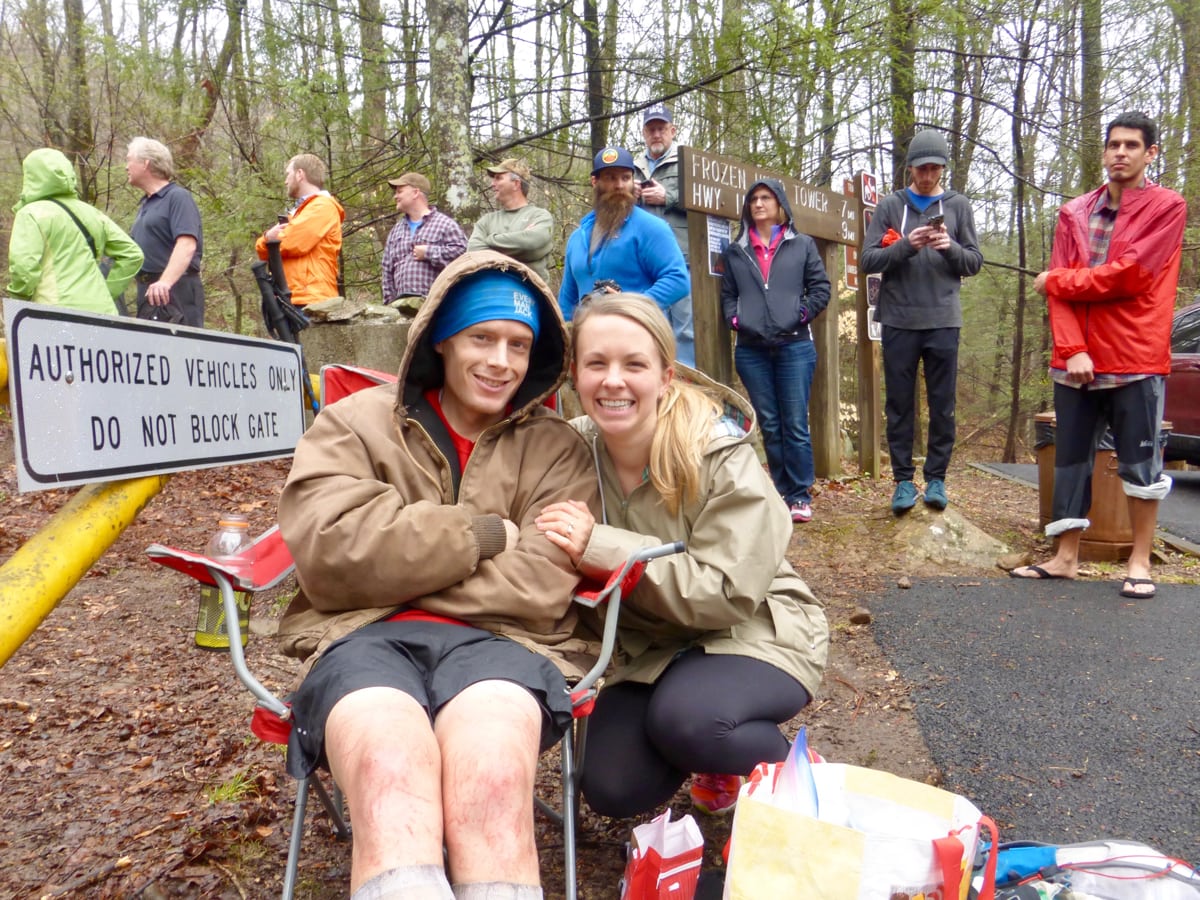[Editor’s Note: On Monday, April 3, John Kelly became the Barkley Marathons’s 15th finisher when he completed the five-loop race in 59 hours, 30 minutes, and 53 seconds. Here is his report.]
Call me Ishmael. No, actually don’t do that. This isn’t a story about my insane captain’s obsessive and ill-fated pursuit of a white whale. There’s not even an actual white whale. This is the final chapter of the story of my own obsessive three-year pursuit of the Barkley, and its yellow gate in the Tennessee mountains. My pursuit was not ill-fated, but whether or not it makes me a little insane is something I hope the story itself can help answer.
Barkley Preparations
It’s impossible to fully prepare for Barkley. Focusing on just one aspect of the race ensures failure, because a strength in a single area is never enough to get through the race and a weakness in a single area can be fatal. Focusing on everything is impossible, though, because time constraints are a thing and there are just too many factors and too many unknowns. Still, though, I felt I was as prepared as possible after three and a half years of work, two previous failures, and a thorough analysis of all the known variables (in much the same way that I would approach a data science problem). In 2015, I failed after three loops, a harsh introduction to Barkley where I had been doomed by a poor nutrition strategy. In 2016, I failed just after starting the fifth loop, done in by navigational errors that led to sleep deprivation. If the best teachers are your own mistakes, I had received some world-class tutelage.
Physically, I was in a great place. One of my concerns when my wife and I decided to give another go at Barkley this year was whether I would be able to train sufficiently. We welcomed twins to our family in October, giving us three kids under three years of age. There was a bit of a slow start to my Barkley training, but thanks to my wife’s superhuman efforts, the twins’ own outstanding efforts at sleeping, and some good planning, my training had been solid and I had even gotten in some good build-up races including JFK 50 Mile, Hellgate 100k, and The Wild Oak Trail (TWOT) 100 Mile.

Receiving my award at TWOT 100 from one of the early Barkley veterans and ultrarunning pioneers, Dennis Herr. This is the apple butter that would refuel me before loops at Barkley. Photo: Antoinette Landragin
Mentally, I had never had a better outlook. In 2015, I had honestly been a bit scared leading into the race. In 2016, I had confidence, but was still highly anxious. This year, I was genuinely excited about getting out there and enjoying the woods and the mountains. I had originally been concerned that there might be increased expectations and pressure after my four solo loops the year before, but then I had the great fortune of a number of elite, well-known runners being entered into the race. I was once again the relative unknown and underdog, a perception that just provided motivation rather than pressure. Perceptions do nothing to affect actual capabilities, and if Vegas had been taking bets on the race I would have confidently placed a large amount on myself. Confidence is critical in pursuit of the white whale called Barkley, and anyone who considers the possibility of doing less than five loops has failed before the conch is even blown.
Strategically, I could not have been in better shape. I knew the course well: how to approach each section, what times I needed to hit, and most importantly where disaster could be waiting and how to avoid it. My crew was an all-star lineup: Julian Jamison and John Fegyveresi (Fegy), and on-the-spot unflagging support from my local cousin Joe Kelly. Loop transitions would be lessons in efficiency, with me placing complete trust in my crew and saving every last valuable minute getting back on the course as quickly as possible.
So it was that I arrived at Frozen Head State Park with doubts about just one variable that I could influence (I waste no energy worrying about the many that I can’t): sleep. Each of the previous two years had had late starts, and I had hardly slept the night before. When those races started I was already at close to 30 hours since a decent night’s sleep. This year I had been ‘practicing’ my sleep: sound machine, ear plugs, and an herbal supplement that supposedly helped me relax. Even if I woke up groggy, come Loop 5 it would be more than a fair trade for having gotten some amount of decent sleep before the race.
Pre-Race
Getting everything in order the day before the race took me longer than anticipated. I was able to get to bed at about 8:30 p.m., but even with my practice, sleep did not come easy. I laid there in the back of a family friend’s van until just after midnight before I finally drifted off. Once I did, though, I immediately went into a good, sound sleep that would last me until the morning.
“TAP. TAP. TAP”
I looked down at my watch. 12:47 a.m. I looked up, and Julian’s headlight was shining at me through the van’s window. I motioned for him to open the door.
“Did he seriously blow the conch?”
“Yeah, at 12:42.”
All I could do was laugh. For the first time in three years, I had fallen into a good pre-race sleep, only to have the conch blow about half an hour later for a 1:42 a.m. start. And a five-loop finish would now require Loops 1, 3, and 5 to be mostly in the dark. Oh well, this was one of the variables I couldn’t control, and I wasted little energy thinking about it. In some ways, it could even be viewed as a positive: instead of starting the race with close to 30 hours since waking up from my last good sleep, it will have only been about 18.
Instantly, ‘the plan’ went into action. Julian, Fegy, and myself had everything laid out for the race in meticulous detail, including contingency plans for the variables we could not control. Barkley strategy is much like a chess match: trying to anticipate the future moves of your opponent (the course) in order to make your best move now. The further ahead you can think the better your chances are, and with our collective experience we could think pretty far ahead. The white whale had moved first, and now we responded.
Loop 1 – Chaos
We headed up Bird Mountain in a strong group. With all of the great runners in this year’s race, I fully expected there to be a group at the front for at least the first loop. What other runners do is another variable I can’t control, though, and Barkley reality is often starkly different from even the most confident expectations. As we neared the top, we entered a dense fog. With my headlamp reflecting back in my face I could hardly see my own hand stretched in front of me. Chaos ensued.
I confidently turned off the trail heading for the first book, a large group following closely behind. We were headed in the right direction, but in the fog we couldn’t see any of the normal landmarks. The correct move here would have been to check a bearing and proceed steadily on course. In the early race excitement, though, we weren’t looking more than a single move ahead. We continued moving quickly and veered left off the correct path. By the time we got to the book it had already been located by other groups, who had been slower but truer through the fog.
This is where it’s easy for a Barkley mishap to become a full-blown disaster. In an effort to move back to the front, people rushed off from the first book toward the first big descent. They went too far south, and I reeled them back toward the right direction, but when it’s that early, patience is at a premium and staying with the group seems to carry more value than actually moving in the right direction. As soon as one person started downhill the rest darted after like lemmings.
I had come into the race completely set on running my own race, regardless of what others did. I knew that I could navigate solo and honestly didn’t want to be in a large group. I should have stuck with that plan, but with the dense fog making a group more advantageous and last year’s early separation from the lead group echoing in my head, I couldn’t resist the magnetic pull down the hill. It wasn’t the optimal starting point and I knew the terrain would be rough, but I also knew that I could still navigate down from there and hoped that I could drag a few people with me for extra sets of eyes in the fog. We reached the bottom slowly, but on target and with the kind of small group I was hoping for.
We had another climb on actual trail to collect ourselves and get back in the right state of mind. On the descent to Book 2, I was determined to avoid the previous year’s disaster. As with Book 1, I left the trail and started us on the perfect line. I actually led us right to the book! The fog was so thick, though, that we didn’t actually recognize that we were at the book. We kept moving past it down the creek. By the time we returned to the book, multiple groups had again passed us.
This trend would continue. On the way to Book 3 we walked right over a trail without noticing it, on the way to Book 4 we were standing right below a bluff that we needed to be on top of and did not even see that the bluff was there, and on the way to Book 5 we walked right across a Jeep road (a well-defined dirt road!) and didn’t notice. I’m still not sure how that last one happened. Perhaps our greatest moment in our audition for Stooges in the Fog was when there were four of us standing there looking at our maps, checking our compasses, and exclaiming, “Where’s the trail?! It has to be right here!” It was no more than two feet away from us the entire time. We couldn’t even find the white whale. In fact, we couldn’t have even found a literal, giant white whale.
I still feel horrible for those early race errors; all those people were relying on me for navigation and I failed multiple times. As the fog started to lift there were just three of us left together: myself, Gary Robbins, and Jason Lantz. We had given away at least an hour and a half to the course. A finish was still doable, and given that we would have a daytime Loop 2, I actually considered us to be in better position at that point than I was in the year before, when the whale had literally gone for my throat and left me running around lost and panicked. A huge confidence builder in bad situations is having the experience of even worse situations to reflect on. We were definitely playing from behind and could not afford further mistakes, but we had avoided complete disaster.
We began moving with the focus and rhythm that we should have had from the very start. We had a less-than-optimal line down Stallion Mountain, but otherwise navigated the rest of the loop flawlessly. On Rat Jaw I felt my usual surge of energy and we passed a group of four that had navigated the early portion without error (and with much less energy). By the time we returned to camp, only Gary and I remained at the front. Barkley had made a mockery of our own predictions that we would still be in a large group, leaving us scattered about like wreckage in the high seas. We came in just after 11 a.m. for a 9:29 first loop, an hour and a half behind where Jared Campbell and Gary had been the year before (and half an hour behind even where I had been following my disaster).
Loops 2 and 3 – Survival
By the end of Loop 1, Gary and I both knew that we needed to stay together. We were moving at a solid pace and neither of us could afford any more mistakes. Even with my knowledge of the course, I knew that a single mental lapse could result in a race-ending disaster. A second set of eyes is an insurance policy: it might cost slightly more to move together, but the odds that both people will have a mental lapse at the same time is much lower. Disasters–ambushes by the whale–are much less likely.
I had a plan to get in and out of camp as quickly as possible. If it weren’t for my wet feet I may not have even sat down. My crew jumped into action like it was a NASCAR pit stop and I was quickly back out for Loop 2. I had told Gary that I would take it easy on the initial climb to give him a chance to catch me before the first descent. We regrouped on Chimney Top (one of laz’s curveballs this year is that Loops 2 and 4 were in reverse instead of Loops 3 and 4). The mission was survival: no more mistakes and we could stay just ahead of the unofficial cutoff times needed for a realistic chance of finishing.
We worked well together: him the by-the-book navigator always checking bearings, and me the instinctive navigator who read and followed the lay of the land. With good communication, the styles complemented each other quite nicely. There were quite a few times I corrected him, and quite a few times he corrected me. We relentlessly moved forward, staying just ahead of Barkley’s scythe without trying to make up too much ground too quickly and flaming out.
The early start caused another interesting twist: we would end Loop 2 in the dark and Loop 3 in the daylight. Wasting daylight is a mortal sin at Barkley, so the normal post Loop-3 nap would not be an option. Gary had his mind set on a nap after Loop 2, and was planning on over an hour in camp. I had planned on another quick transition, but after playing the different scenarios out in my head, I relented. In exchange, Gary agreed to limit time in camp to 50 minutes. We arrived back at camp at around 10 p.m. after a second loop of around 10:40, for a total time of 20:19.
My biggest fear with taking a nap that early is that I would lie there and just waste the time, unable to fall asleep. I believe I did get about 15 minutes, though, and with the longer stay in camp I also had a chance to get some good calories in before heading back to the gate for another night loop.

Emerging from my nap to start Loop 3. Photo: Josh Patton Designs
Despite the night, our excellent navigation continued. We circled the course without a major issue, and were welcomed at Rat Jaw by one of the most beautiful sunrises I believe I’ll ever see. A dense fog had settled into the valley below us, looking like a giant lake nestled in between the ridges. Above, a battle raged across the entire horizon with the bright-orange hues of the approaching sun and the darker shades of the fleeing night meeting on a battlefield of purple.
We finished our ‘fun’ run in just under 33 hours at around 10:40 a.m. on Sunday with a Loop-3 time of about 11:40. We were still an hour and a half behind last year’s lead pace, but we were about to make up a significant chunk of time because we wouldn’t be napping after Loop 3. With another quick turnaround, we headed back out at about the same time that I had started Loop 4 the previous year. But this time Loop 4 was mostly in the daytime, I wasn’t solo, and I had at least notched one nap earlier. Our odds were starting to look up, and a good Loop 4 would completely turn the tables and put Barkley on the defensive.
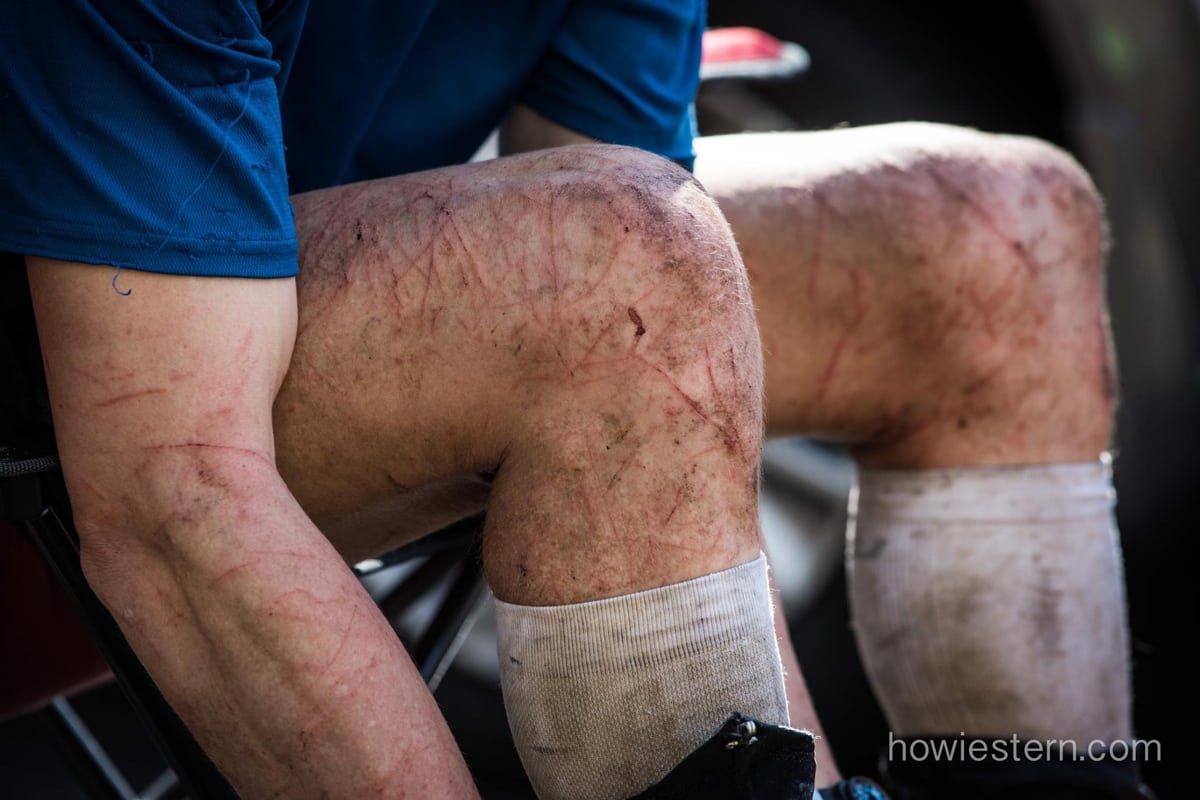
Rat Bites. They look worse than they are. I promise. Sort of. But no really they heal. Photo: Howie Stern Photography
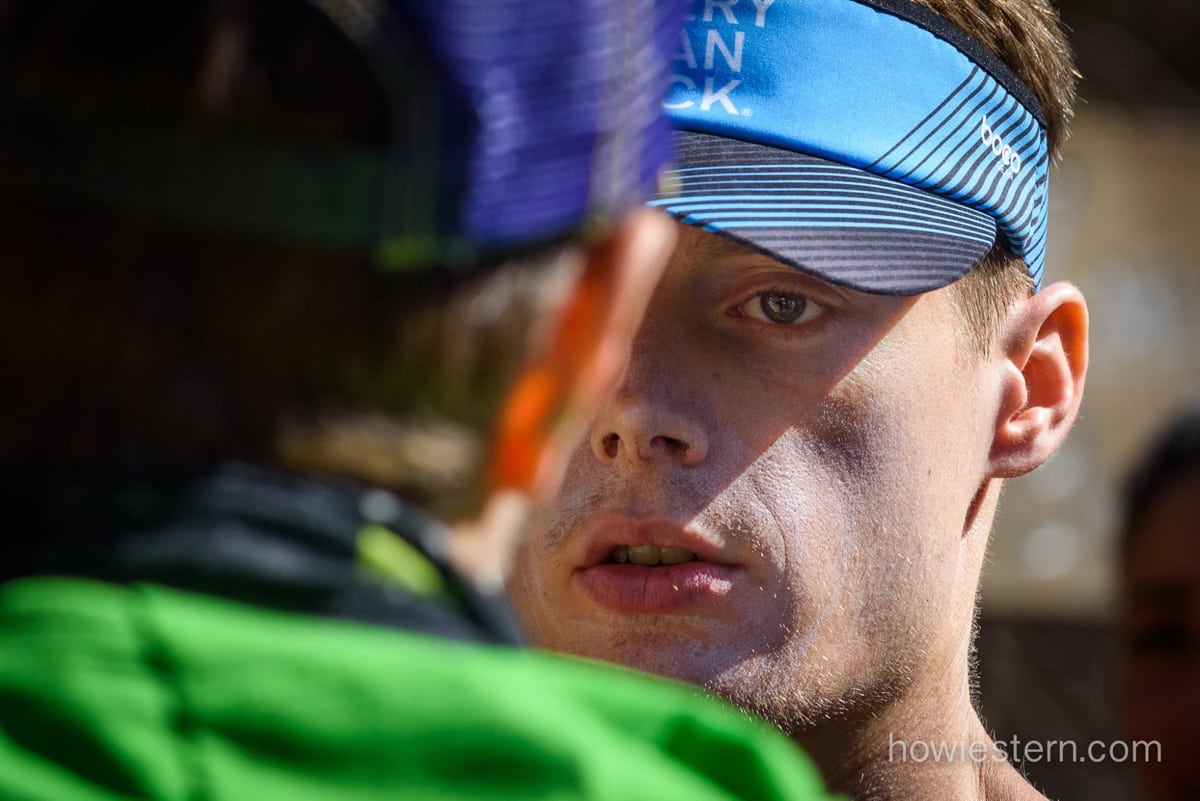
Fegy pep talk before Loop 4. Photo: Howie Stern Photography
Loop 4 – Barkley Fights Back
We had managed to keep ourselves in position for a finish, but we started to feel the early effects of sleep deprivation. Things that were familiar appeared to not be familiar. Heading down the first descent I took us on what I thought to be the correct spur. About halfway down, though, nothing looked right. We had come down a bit too far north, or at least we thought we had. I hit the panic button a little and started taking off south, looking frantically for something familiar. I flew right past the book, but fortunately did not leave earshot of Gary. He was intimately familiar with the area due to previous mistakes there, and made his way directly to the book. It could have been a disaster, but fortunately we didn’t lose much time and were still looking good.
We snapped back into focus and continued on our mission. The forecast for the day was in the 80’s Fahrenheit, and on the next ascent the heat began to bear down. If we moved too fast we would be in danger of quickly burning ourselves out. I constantly doused my head with my water bottle and refilled frequently with the cool water from the creeks. At the top there was a nice breeze and it was tempting to linger and enjoy it, but we had to keep moving.
We faced a full ascent of Rat Jaw in the heat of the afternoon. The climb is fully exposed on southwestern slopes with no water along the way. I had the choice of starting that ascent with my bottles on empty, or of refilling with the water flowing underneath the prison. Water, water everywhere and not a drop to drink? Nope. I hope to not say this too many more times in my life, but prison drainage was the clear winner. The prison water sustained me through the climb until I was able to replace it with the water at the top. By that point, all the water left was for me and Gary, so we generously doused ourselves before starting back down.
We continued on through the heat. Our navigation was good, but we were forced to move slower than we would have liked. One fortunate side effect at least was that most of the muddy slopes had dried out by that point. We conquered Stallion Mountain still on pace, and stopped briefly at Garden Spot to get out our headlamps, soak in the twilight, and let our thoughts momentarily turn to things larger than the next book or the race itself.
By the time we grabbed our Bald Knob book, we had finally clawed ourselves back into a comfortable position. If we could navigate the course through the final two books without incident, then we could get back to camp with around 15 hours remaining: enough for a nap and a slow and cautious Loop 5.
As we descended toward the next book, though (a fairly straightforward and easy descent), we managed to veer a bit too far west. With the onset of night and the steady progression of sleep deprivation, we lost sense of where we were. As we scanned for recognizable landmarks, checked our maps, and discussed the options, I collapsed in a pile of leaves.
“John? John!”
I looked up, and Gary was yelling back at me. I’m not sure if I had fallen asleep, but for a moment I was certainly not there. The shock and fright of the experience instantly knocked me back into action. I was more alert than I had been in a long time. And I knew this area. Of course I did. Just like Gary’s experience from 2016 mistakes had saved the beginning of our loop, mine was about to save its end. I took off like a bloodhound nearing its target. With a near-direct line, we arrived at the book and averted another disaster.
We had lost time, but were still in pretty good shape. We made it to the last book without issue and just needed to make it to the trail and back down into camp. We hadn’t had much of the usual Loop 4 nighttime, though, and the whale was intent on making the best of the time it did have to strike back hardest. It was an animal in a corner, and we were slowly letting our guard down. As we approached the trail, we convinced ourselves that we had gone off course somehow. Again, nothing looked familiar. We had eaten into our remaining cushion enough that even small mistakes were big at this point. We checked our bearings, and checked our maps, and repeated. I didn’t see how we could have gone wrong. As we kept checking we kept gradually moving forward, until eventually, we found ourselves at the trail.
Wait, what?! We were right all along, and on a portion that neither of us (and maybe no one else) had ever had an issue with. How is it possible that things had looked so unfamiliar and wrong? In any case, our remaining luxury cushion was gone. Our mistakes at the end of the loop had changed my own narrative from ‘easy Loop 5 after a nap’ to ‘tight Loop 5 with no nap.’ We returned to camp about 20 minutes past midnight after a painful Loop-4 time of about 13:20 put us at 46:26 for the race.
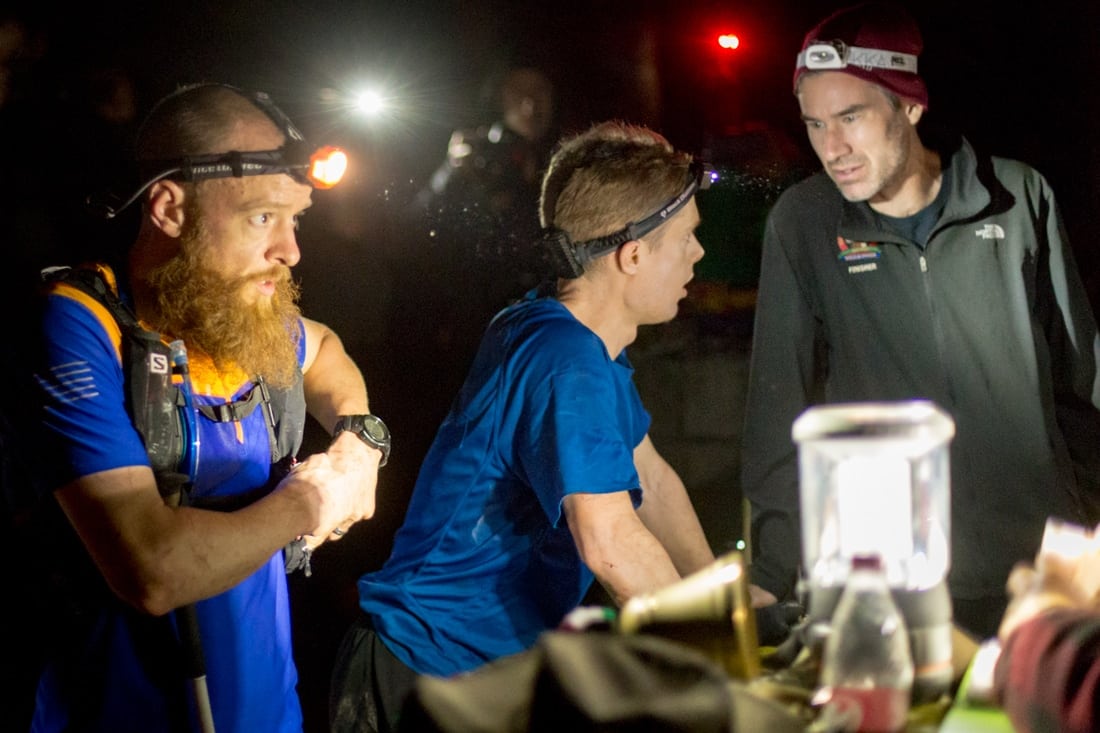
Finishing Loop 4. Photo: Josh Patton Designs
Loop 5 Directions
Gary and I had originally both wanted clockwise for the final loop. We discussed possibly doing paper, rock, scissors, or going by the rules and whoever got out first got it. The latter option would essentially provide a value tradeoff between loop direction and loop preparation or napping. Both of us wanted to avoid any sort of race back to camp, though, as that would only hurt both of us.
We tabled the discussion for a while, but about halfway through Loop 4, Gary suddenly said that he would do counterclockwise. He felt that there would be some benefit to him in that direction and he wanted the certainty ahead of time in order to be able to think through things and plan in his head. He also recognized that I had been transitioning much faster and would likely get out first. Gary led the remainder of Loop 4 as practice.
I didn’t tell him this before his decision, as I didn’t want it to alter his thinking, but I wanted clockwise for reasons beyond just being more confident in that direction. The clockwise direction ended on Chimney Top, the mountain that I had looked up to and hiked on throughout my childhood. I had always envisioned getting my last page there, on the very spot where my love of the mountains had begun, and looking down at my family’s farm triumphantly before beginning my final descent to camp. The Barkley was laughing quietly at my vision, but ever since a finish was no more than a twinkle in my eye, it’s the only way I had imagined it.
I’m still extremely grateful to Gary for this, and it was a huge stress relief to not have to figure it out later or race each other out of camp. Working with Gary for four loops had not only been successful, it had been enjoyable and a great experience getting to know him and his tremendous character. I would be proud to run up and down mountains with him any day.
Loop 5 – Me Against Myself
I got in and out of camp quickly thanks again to my unbelievable crew. I was still contemplating a nap, but my crew was completely against the idea. My mind was starting to fade and I was worried about another collapse in a random leaf pile, but they said I looked alert. It was the right call. As I would soon find out, the swings between alert and out of it can be quick and unpredictable. Any moment of alertness absolutely has to be fully taken advantage of.

Starting Loop 5. Photo: Josh Patton Designs
I started the loop with 13:22 remaining. There wasn’t much room for error, but it was very doable. It was actually slightly more time than Jared had the year before, but I was also fighting a much bigger sleep deficit and had to deal with more night time. It was a good hour and 20 minutes more for Loop 5 than I had the year before, and I was physically and mentally in much better shape. I pushed up Bird Mountain and made good time to the first book. I was really feeling the sleep deprivation, but I was able to focus and keep moving forward. As soon as I descended from that first book, I was further into the race than I had ever been.
By the time I started the next climb, though, I was in a bad spot. I couldn’t think straight (or run straight) and I seriously feared that I would fall asleep while moving and wake up without enough time remaining. I was approaching 64 hours with less than an hour of sleep. I had to have sleep. There was no choice. No matter how much I tried to focus, I couldn’t keep myself moving and I couldn’t discern reality from a dream. It was similar to how I felt just before quitting the year before. The difference, though, is that I still had the white whale in my sights. I could still do this.
I decided that if I were going to sleep, it would be on my terms. I didn’t trust the alarm on the cheap watches that laz gave us, but I knew there would be a cold wind at the top of the ridge I was climbing. I fought to the top, and found the most miserable spot I could. I knew that after 10 or 15 minutes my body would have a choice: wake up and get moving, or lie there suffering in the cold.
It worked perfectly. After the quick nap my head was cleared and good to go. It’s amazing what a power nap can do for the mind. I continued at a strong, steady pace, and was navigating flawlessly. My legs still felt great and I pushed on and up to Bald Knob. Fifteen minutes can’t replace three nights of sleep for long, though, and I slipped back into a state of delirium.
The peak of Bald Knob is quite small, and there are only a few places up there for a book to even be. But I couldn’t find it. I ran back and forth. I searched in a grid pattern. There was no book! After all this was my race doomed by a missing book? Had an animal taken it? Gary and I had left it here just a few hours earlier. Was I on the wrong peak somehow? Could this be Squire Knob? No, no that just wasn’t possible. Just as I started to feel that familiar pang of panic, I saw my headlamp reflect back off the book’s bag. I must have run right by it half a dozen times. I still wasn’t sure how it was possible, but I grabbed my page and kept moving.
The most dangerous sections of the course to me were now the trails. Without a need to focus on navigation, my mind could drift and quickly end up asleep. I can’t imagine feeling any more like a zombie than how I felt on climbs: legs relentlessly moving while my head was just along for the ride. Caffeine had started to lose its effect as well. By the time I reached Garden Spot, I knew I was going to need another nap. I wanted to push as far as possible, though, as the farther along I got the more likely it would be that if I overslept Gary would come across me and be able to wake me up with enough time left on the clock.
As I covered each section, it was odd for me to think about how it was the last time that I would do so. The reward for finishing five loops at Barkley is that you don’t have to do another one, and at this point that sounded like the greatest prize ever offered by any race in history.
By the time I reached the top of Stallion Mountain, I had reached my limit on going without a nap. The spot also met my criteria: cold, windy, and miserable. There was even a big rock that I could lie on. I was out cold as soon as my face hit that rock. It was as if I had crawled into a luxurious king-size bed. It was so comfortable, in fact, that I hit my imaginary snooze button the first time I woke up. The second time, though, I quickly came back to my senses. This wasn’t a luxury hotel. It was a rock on top of a strip-mined mountain. I had to get moving.
I barreled down Stallion Mountain. It was purely a mental battle at this point. Physically, I was still feeling good except for some blisters and bruised toes. I had stopped taking Tylenol or anything else for them because I thought that they might help keep me awake. I could take my physical negative and make it a mental positive, a no-brainer of a trade at the time (which was good, because I basically no longer had a functioning brain).
Normally the sunrise in an overnight ultra is an incredibly uplifting experience. This morning was bleak, though, and it brought a steady rain with it. I put on the warm clothes that I had and quickly found that they weren’t enough. As long as I kept moving I would not be in any danger, and I again felt that the discomfort might help keep me awake. So I had something that would force me to keep moving and that made me less likely to fall asleep. My physical negative had again become a mental positive. Barkley was being Barkley and throwing last-ditch obstacles in my way, but my riposte was quick and true. Or so I thought.
I came up a little high on Danger Dave’s Climbing Wall and became momentarily disoriented, but I quickly corrected and made my way toward Rat Jaw. The whale was not about to give in, and a stiff wind turned up the miserable factor beyond the ‘just uncomfortable enough to stay awake’ level. As I made the muddy climb up Rat Jaw, the cold continued to become more severe.
I desperately scanned the briars, looking for anything in them that might help. First, a grocery bag! This would make a perfect poncho. I slipped it on and kept moving. The briars were making quick work of my bag poncho, but then… a nice thick orange toboggan!!! It was the find of a lifetime. [Author’s Note: A toboggan is what us East Tennesseans call the hats that you might refer to as beanies, or knit caps… alright y’all?] When I slipped it on I could immediately feel the added warmth. It felt like Frosty’s hat, and I started to dance the rest of the way up Rat Jaw. What I couldn’t stop thinking about was how the briars on Rat Jaw had stolen my favorite toboggan right out of my pocket on Loop 4 in the previous year. Rat Jaw taketh away, and Rat Jaw giveth back (just in a much brighter hue).
I reached the top to the cheers of Fegy, Ed (one of my high-school cross-country teammates), Conrad, and Annie. The wind was brutal on top and I quickly grabbed my page and departed without even refilling my water. For the entire loop I had been trying to plan my pace for getting to the top of Rat Jaw with five hours remaining, which I felt would give me a pretty comfortable margin. I made it with four and a half hours. On an early loop in good conditions I could do the remaining section in under three hours, but my current situation was obviously far different. I was still a single navigational error from failure.
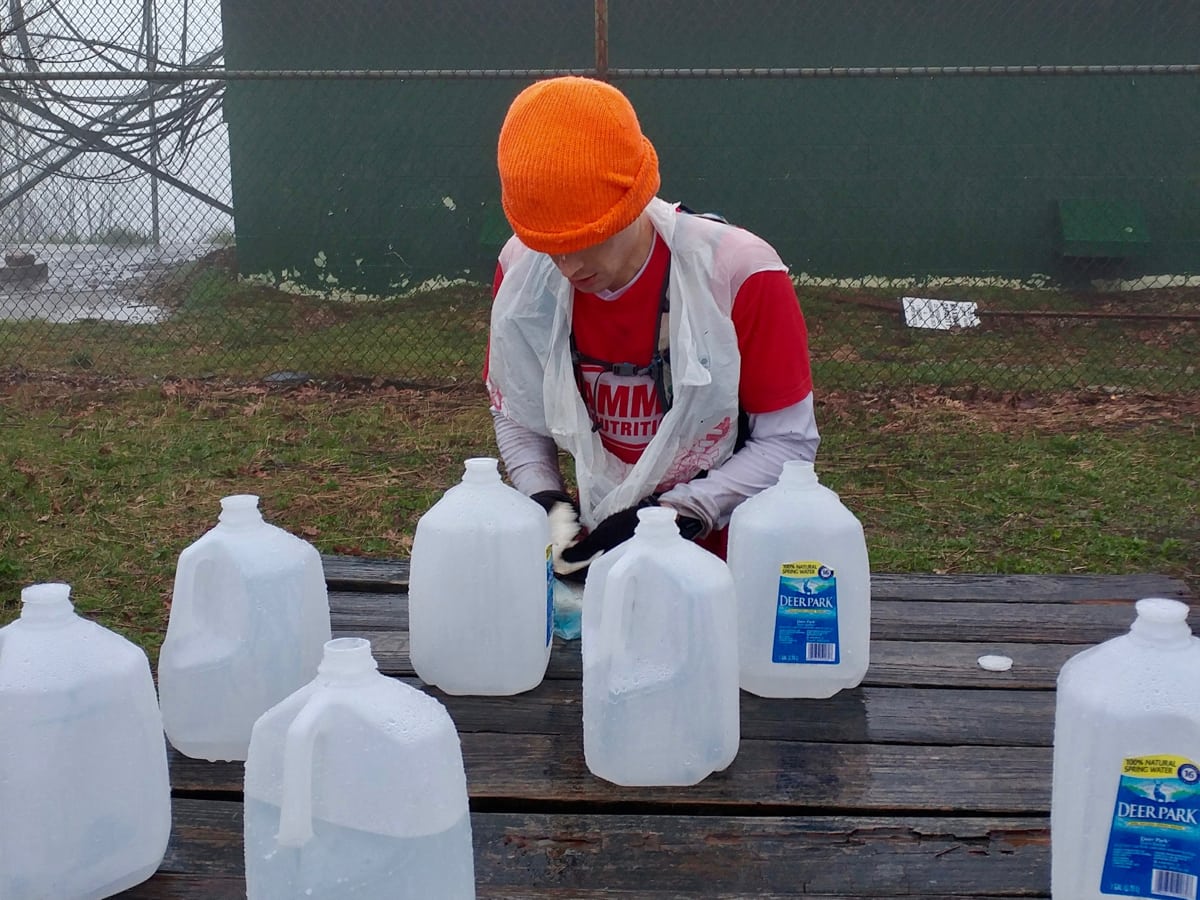
Getting my page from the top of Rat Jaw on Loop 5, sporting my new stylish apparel. Photo: Ed Aramayo
I was looking forward to reaching the prison tunnel at the bottom of Rat Jaw, which I thought would offer a respite from the cold and the wind and give me a chance to refill my bottles with power, I mean prison, water. Unfortunately the wind was blowing straight through the tunnel and the water was rushing through it, even pouring in from the sides and bursting up from the bottom like little geysers. I was already wet, so no big deal on the water, and again maybe it was for the best that I was forced to keep moving quickly.
I started up Razor Ridge towards the Eye of the Needle, a climb that I had really never had issues with. The rain had brought the fog back with it, though, and I was unable to accurately gauge my progress on the climb and navigate using the capstones at the top. When they finally came into view I was a bit worried that I had missed and would lose time searching for the correct one. But I nailed it. I came up right to the book and grabbed my page. I just needed a good descent of Zipline and I would be in great shape.
As mentioned earlier, I largely use the lay of the land for navigation, and that generally works quite well at Barkley. I use my compass mostly to get started in the right initial direction and to double check myself as I go, but the course follows the terrain’s natural features and those really offer all the navigational aids that are needed. It’s not an orienteering event.
Going down Zipline I navigate using a few creeks that flow down the drainage. With the rain, there must have been a dozen creeks. The fog made the situation even worse. All I had to do, though, (or so it seemed) was navigate this one last off-trail descent. I proceeded cautiously, not recognizing much in the fog. Finally, I recognized the old trail that I could follow the rest of the way to the bottom! I hopped on it and quickly made my way down to the book.
Here I was, at the base of Chimney Top. I had one last climb before I could rip out that final page at the top. My legs started working their way up the climb, still feeling strong. I kept going, and going, and going, and…. seriously, where’s the top of this thing? The climb seemed endless, and in the fog I couldn’t see any references to measure my progress. Every time I thought I saw the top, it was just a slight lip and the climb continued. As long as I was going up, though, it was impossible to go the wrong way. Finally, I saw the capstone!
Here was the moment I had dreamed about for years. I stood on Chimney Top and I tore my final page out of the book! It was cold, and wet, and miserable. And it was so foggy that I could hardly see two trees at once, much less see all the way to the bottom toward my family’s farm. Just how I had imagined it… wait, wait no this wasn’t right at all. I had won, but had chased the whale into the forlorn fog to do so. No matter, I still had my easy descent to camp to soak it in and enjoy it. I checked my watch. An hour and 40 minutes. Tons of time…
I stood amongst the capstones, my mind in as much of a fog as Chimney Top’s peak. I checked my watch. An hour and 20 minutes?! Where had 20 minutes gone? My mind had completely lost the last 20 minutes, as if I had just skipped forward in time. Nothing looked familiar. How had I gotten there? Was I still on the right peak? Was this even real? I could feel my mind slipping away, the way it had on my failed Loop 5 the year before. The whale was only injured, and fighting back fiercely.
I held on to thin threads of reality. I thought of Andrew Thompson’s legendary 2005 race report and his failure after completely losing grasp of reality on Loop 5. I had to stay focused, to remember what I was doing there. The thousands of hill repeats, everything my wife had done to help me reach this point, there was nothing Barkley could do to make me forget those. No, I’ve still got this. I’ve got to stay with it. Think John, what do you need to do?
The trail! I have to get to the trail and take it to camp. But I didn’t recognize anything. I worked my way back to the southern capstone and relocated the book. Okay, I wasn’t crazy. This was really Barkley and I was still at the right place. I just had to navigate the capstones between the book and the Chimney Top Trail, an easy task that I had done a dozen times without any issue at all. I started moving toward the trail, but again nothing looked familiar. How is this happening? It’s so easy!
I kept going back to the starting point and trying again, each time quickly feeling lost. Eventually I just kept moving forward, checking my compass to keep moving perpendicular to the trail. Then, out of the corner of my eye I saw a green blaze. A glorious green blaze! I ran to it and stepped foot onto the trail. I knew to turn left, but I took one last compass bearing to be absolutely sure I turned the right direction, and then took off toward camp.
In my mind’s eye, this final section had been a relaxed victory march down the mountain. As with my Chimney Top experience, reality was vastly different. By that point I was losing it. Again I felt like I would fall asleep if I blinked for too long, and even awake I didn’t feel like I was awake, or that anything was real. I was going to be the guy who got all my pages and then fell asleep and timed out.
I picked up a rather aggressive pace for that point in the race, both to stay alert and to give myself less time to fall asleep before I hit the gate. I knew that I couldn’t maintain a full grasp on reality, but thought that it might be sufficient at that point if I could identify a single part of it and hold on to that. I fixated on a single thought, This is really Barkley. It’s really Loop 5. You really have all your pages. All you have to do is go touch the gate. Go touch the gate, John! Touch the gate! If I could just stay awake, and remember what I was doing, Barkley was mine. At that point, though, those felt like two pretty big ifs.
After the longest 30-minute descent of my life, I reached the bottom. I had a creek crossing, and then just half a mile of walking trail back into camp. I stepped into the normally calm and shallow creek and was quickly knocked over by the torrent of water running off the mountains from the rain. My mind snapped back into action and I desperately started jabbing my poles in front of me as I began to get pulled downstream.
I finally felt my pole sink into a solid location and stop my journey downstream. Carefully, I returned to my feet and made it the rest of the way across the creek. This was it. I had returned to where sane people might be on a day like this. I took off on a run back to camp.
As I entered the campground, the scene was everything I could have ever imagined except for one thing: me. I thought that I would walk the final hundred yards back to the gate, really soaking in the moment. I was still legitimately concerned that I could fall asleep at any second, so I kept running.
I reached out with both hands to touch the gate at 1:12 p.m. on Monday April 3 after 59 hours, 30 minutes, and 53 seconds out there. Suddenly everything that I had kept so focused and tightly bundled up for the previous 13 hours was released. Physically, mentally, emotionally, everything just gave out at once and I collapsed into a chair. My mind was free and could finally think about something other than staying awake. I had finished Barkley. The white whale was dead.
Post-Race
As I sat at the gate, I fully expected to see Gary coming down Bird Mountain at any moment. He made it through the most difficult part of his loop in good time, and I was confident that he would make it in. I honestly didn’t really care which of us made it in first, as long as we both made it in. As we all waited, I sat there trying to begin to process what I had just done. It was a moment I had worked toward for over three years, and dreamed about for longer.
For me, Barkley had started as a very internally motivated goal. I wanted to see what my limits were and see how far I could push them, and to do it in the very mountains I call home. To paraphrase laz, I also wanted to give myself that chance to experience the extreme joy in sport that is only possible when failure is probable. As a Texas Rangers, Cincinnati Bengals, and North Carolina State fan, I’m quite familiar with the concept. (Seriously, if I can finish Barkley, one of you can win an actual championship in my lifetime already.)
As my journey progressed from 2015 until the moment I touched that gate for the fifth time, the motivation had become so much more meaningful. In 2015, I saw the excitement it brought to my family and the local community. After 2016, I received so many messages of encouragement and stories of how my effort had inspired people. Completing this race was about more than learning my own limits; it was about inspiring and motivating others to find theirs and to never give up in trying to push them further.
Sitting at the gate, it was amazing to have my local family and friends from the community there and to see their pride over my finish. These were our mountains, and I had finally made good on showing that. I’ll never forget that moment, and I’m grateful that I have so many pictures and videos and people who were sharing in that moment. I at least need something to know that it was real, and not another figment of my sleep-deprived imagination.

Waiting. Photo: Howie Stern Photography
As the clock ticked toward 60 hours, we started to face the terrible reality that Gary was not going to make it. The whale had claimed one last victim. Then at the last minute, we saw him running toward the gate, but from the wrong direction? He touched just over time, but confusion immediately set in as to how he had arrived from the other side. laz and I looked at my map, and Gary was finally able to tell his story. It was heartbreaking, and I couldn’t imagine the pain he felt. I knew the time and commitment that he had put into preparing for Barkley and to come up just short after such a simple mistake, just turning the wrong way on the trail back to camp, it was unimaginable.
Another thing laz has said is that, “Those who know what you did, know that you did it.” laz said this long before this year’s race and was referring to the accomplishments of past runners and the impossibility of anyone who hasn’t experienced Barkley truly understanding it, but I could not think of a better way of expressing my feelings on Gary’s race. I know what he did, and it was amazing. Barkley is about finding personal limits, and the outcomes live on a continuous spectrum; it’s not just finishers and non-finishers. Gary’s achievement is 99% of a finish, and he did it in extremely difficult conditions. I’m proud to have run with him for four loops and look forward to hearing his story in more detail when he’s ready to share it. It’s one for him to tell, in his own time and his own words.
The Voyage Home
The support and excitement generated from the race has been unbelievable. The introvert in me, the part that originally approached Barkley with internal motivation, honestly kind of wishes I had finished pre-Barkley Marathons documentary, before the race increased so much in popularity, and could just go home with my accomplishment and hide. The bigger part of me, though, has found it incredible to see all the messages relaying how people have been inspired. It’s more meaningful than anything I would have imagined even after last year’s race, and I truly hope to be able to build upon it to continue motivating others in the future.
That will at least have to wait until I’m fully recovered, though, and so far that process has also been more than I ever would have imagined. At one point I heard three-time finisher Jared Campbell tell laz that a loop extracted part of his soul, and while I thought at the time that it was just an expression, that’s honestly how I felt for days following that fifth loop. I was a shell, and the toll that it had taken on me physically and mentally was an order of magnitude beyond what the four-plus loops in 2016 had done. Between the early start and the weather at all extremes (fog, hot, cold, rain, hail, wind), the conditions were much worse this year, and if anything I’m glad I got the finish in a ‘hard’ year, but I still significantly underestimated the difficulty and the toll of that final loop.
Physically, I’m not sure where some of the problems came from. I had the normal briar scratches and sore muscles, and I had some bruised toes and blisters, but other things completely baffled me. Why on earth do my ribs hurt, and my fingers?! My thumb had a sharp pain whenever I put pressure on it for a week after the race, until I finally discovered that there was a thorn still fully embedded in it beneath the skin. Apparently I also sprained my right wrist and my left ankle. I can’t remember either of those happening during the race, but here I am a week later and I still can’t walk well on that left foot.
Mentally, it took me a while to be able to actually process and enjoy what I had done. I just couldn’t ‘feel’ anything. It never felt like a Pyrrhic victory, but at times it did feel hollow. Is it the pursuit of goals or the achievement of them that is most rewarding? Part of my mental state was I’m sure due to sleep deprivation, which I’ve slowly caught up on but not as quickly as some might think. Even with such a huge sleep deficit a peaceful, deep sleep doesn’t come easily with an aching body and a mind that’s still keyed up from the race. (And for someone who doesn’t drink coffee, those four pieces of caffeine gum I chewed at once coming down from Chimney Top might still be working their way through my system.)
I’ll come back from it soon enough, and I’ll have the accomplishment and the memory of the race with me for the rest of my life. And when I do come back that extracted portion of my soul will be stronger for it. The main challenge now lies in finding the next athletic challenge. Barkley has been my focus in running for three years, and was essentially a set of moving goalposts to keep me pushing further.
I know that I will have new goals, but in running at least I might find more satisfaction in helping people conquer their own figurative Barkleys than in trying to find another one myself. After all, I certainly didn’t finish my own Barkley without help from others. I’ve built up quite a debt to some of my friends and family over the course of my three attempts: my superhuman wife Jessi who takes care of three kids under three while I work and train (a task more difficult than Barkley in my mind), Julian Jamison and John Fegyveresi who just turned in the Barkley crewing performance of a lifetime, my parents’ unwavering support and help with the kids during the race, my local family and friends including my cousin Joe Kelly who has become a fixture of my crew over the years, my aunts who have baked me delicious snacks to keep me going while I’m out there, and my ‘virtual’ crew Jodi Isenor. On top of that, the support of outstanding companies such as Hammer Nutrition, Ultimate Direction, and Every Man Jack allowed me to worry less about gear, nutrition, and other distractions and put my focus where it was needed on training and strategy.
Some of these things may seem small, but so is the margin of error at Barkley, which is by design. Had I taken only eight more minutes per transition or even just 30 seconds more per book, I would have been over the 60 hours. That’s the true beauty of Barkley and the amazing part of its design. It’s not impossible and it’s not easy; it’s right at the edge of what is possible. Just having the opportunity to shoot for that edge is an opportunity I’m grateful for, and actually reaching it is an achievement of a lifetime that I will never forget.
So back to the original question: does my pursuit of the white whale make me a little insane? Well, maybe just a little, but there’s a method in the madness. I wouldn’t call any human endeavor to test and expand our limits insane. This endeavor itself might seem unattractive to some, as many endeavors that others choose are certainly unattractive to me. People can call Barkley arbitrary and without meaning, or call it not a real race, but really none of that matters to me.
Barkley presented a way to test myself both physically and mentally at the same time in a way that nothing else could, and in a format and location that were attractive to me. This was the test I chose and the results of that test were for me, not to be measured as a race or by any sort of other external gauge. My three-year pursuit has left me as a stronger, better person and that will carry over to a multitude of other areas of my life, ones that are far from arbitrary or meaningless. If in the process I’ve inspired even 10 people to also seek out better versions of themselves, then my results are an order of magnitude beyond what I hoped for and it would have been more insane of me to not continue pursuing my white whale all the way to that yellow gate in the mountains of Tennessee that I call home.
